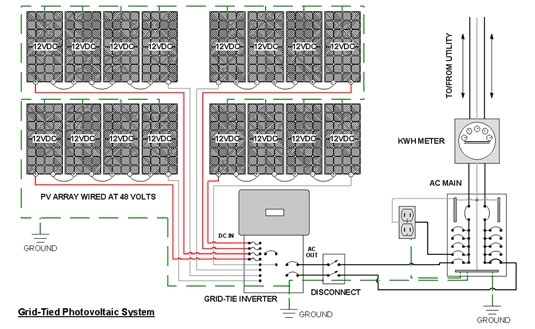In a grid tie solar PV system no energy is wasted – any excess electricity is contributed to the grid.
Grid tie solar systems is particularly worthwhile during periods of
absence of load, during week-ends or holidays for example when your modules
continue to churn out electricity.
This is how a grid tie system is connected to the grid,
There are innumerable technical issues/constraints involved in grid
connected solar PV rooftop, a list highlighting a few are given below.
1. Grid Synchronization – the inverter will automatically sync its
voltage and frequency as per the grid requirements. In India, the grid
is never stable, so will can exp lots of sync issues.
2. Over voltage condition – Grid inverter has to isolate from the grid automatically during this condition
3. Low voltage below the preset value – inverter has to automatically switch off/disconnect within few milliseconds.
4. Islanding: There could always be possibility of something being wrong with the
inverter and it continues to put electricity to the grid in the event of
grid failure. “Grid failure” detection is very important with inverter. So additional AC disconnect should be provided after the inverter (near metering panel) on top of the automatic changer over switch which disconnect from ongrid to off grid during grid power failure.
5. Injection of DC power into the grid – Isolation of DC is very
important. If the inverters are transformerless there is a possibility
of DC injection into the AC side. To avoid this external insolation
transformers must be installed on the AC side/output side of the inverter.
6. THD – Total Harmonic Distortion level should be kept below a certain
value (Voltage-THD should be less than 5% as per CEA regulations). These
harmonics are caused by non-linear load and proper measures must be
taken by the DISCOM by installing harmonic measurement meters and
harmonic filters to maintain it below the regulation level.
7. Voltage level of primary side of distribution transformer (step down
transformer)- usually 11KV in TN. So there is a requirement for
additional transformer which has to collect the output from the big rooftop output
(usually >100kWp) and step us to the 11kV level. Therefore, lots of
additional infrastructure will be required – this is additional cost for the developer/ rooftop owner.
But small rooftops are directly connected to the distribution panel point at the household with a Net meter / separate meter (http://www.gsv-microtech.com/products/datasheets/pqm3.pdf) and a AC disconnect is provided for emergency other than the automatic inverter disconnect, as mentioned in point 4. The voltage levels are usually 3-phase 415V or 1-phase 220V and no separate transformers are required in this case when connected to the grid. Usually most of the above issues mentioned are taken care by the latest grid tie inverters and these inverters also come with inbuilt protection and surge arrests.
A grid tie inverter disconnects automatically when grid failure happens, hence net metering/metering is not possible during this event. This is done in order to protect the electricians working on the line and the inverter, as per the grid regulations. Such inverters are more suitable for countries like Germany and the USA where grid failure or power failure is a rare event. But this could cause serious issues in developing countries like India where power cuts are frequent.
A grid tie inverter disconnects automatically when grid failure happens, hence net metering/metering is not possible during this event. This is done in order to protect the electricians working on the line and the inverter, as per the grid regulations. Such inverters are more suitable for countries like Germany and the USA where grid failure or power failure is a rare event. But this could cause serious issues in developing countries like India where power cuts are frequent.
Solution:
Change over switch:During this condition, the rooftop owner is unable to use the solar power generated even for his own load. Hence there is a need for an off-grid change over switch. This is done along with some changes to the distribution panel (sync with generator for creating reference voltage and current).
Hybrid Inverter: In a hybrid inverter, various sources like PV panels, wind turbines, diesel generators and batteries can be connected simultaneously. These inverters then choose the best possible solution for a particular situation as programmed. However hybrid inverters are preferred for large rooftop systems because of their high cost
Change over switch:During this condition, the rooftop owner is unable to use the solar power generated even for his own load. Hence there is a need for an off-grid change over switch. This is done along with some changes to the distribution panel (sync with generator for creating reference voltage and current).
Hybrid Inverter: In a hybrid inverter, various sources like PV panels, wind turbines, diesel generators and batteries can be connected simultaneously. These inverters then choose the best possible solution for a particular situation as programmed. However hybrid inverters are preferred for large rooftop systems because of their high cost
Now latest hybrid inverters are available in the Indian market which can solve the above islanding issue and make the design more flexible. These systems are available from manufactures like Zigor (from Spain now available in India). A detailed study about these inverters will be discussed in my future blogs.
Please check the power generation graph below for a site in Mumbai - using Zigor grid tie inverter (only grid import, no export)
Reference:
India - Smart grid task force
ZIGOR India Pvt. Ltd


.png)
.bmp)
.bmp)
.bmp)


.png)
.png)

